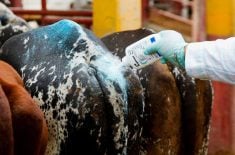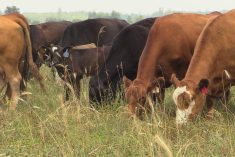(Resource News International) — Facing the U.S. government’s inevitable implementation of country-of-origin-labelling (COOL) this coming fall, the Canadian livestock industry is preparing itself as best it can given the uncertainty surrounding the controversial legislation, according to industry sources.
When COOL is implemented in October, the Canadian livestock industry has made it clear it would prefer it were the amended version introduced in 2007 as part of the latest U.S. Farm Bill.
Compared to the original legislation, introduced in the 2002 Farm Bill, the newer version is seen as far more “user-friendly,” less rigorous in terms of its requirements and compliance enforcement.
Read Also

U.S. livestock: Cattle regain ground, hogs dip
Chicago cattle futures regained ground on Wednesday after falling off a cliff late last week. Most-active December live cattle contracts…
The newer version has not yet been passed, however, as the omnibus 2007 U.S. Farm Bill has stalled due to disagreements between the U.S. Senate, Congress and the Bush administration. Until now, the 2002 Farm Bill has simply been extended.
That being the case, the industry is uncertain as to which version will eventually become law.
One possibility, according to Andrew Dickson, general manager of the Manitoba Pork Council, is that a farm bill will be passed containing all of the issues on which there is agreement, leaving the contentious issues aside for a future bill. A second possibility is that the COOL portion of the bill is simply tacked onto another, unrelated piece of legislation.
A third, less desirable possibility is simply that the original 2002 version will implemented this fall.
Theresa Keddy, communications manager for the Canadian Cattlemen’s Association (CCA) in Calgary, said, “Either way something will happen at the beginning of October and if nothing changes, if it doesn’t get tacked onto another bill, we could see the 2002 version go through.”
In any event, both the cattle and hog sectors are bracing themselves for COOL’s eventual enforcement.
A Canadian beef brand
“We would be very foolish to ignore COOL so I think the best thing we can do is to think it will go through in the worst form and to prepare for that,” Keddy said.
If shipments of Canadian cattle and beef into the U.S. grind to a halt in October, Keddy said there may not be sufficient slaughter capacity in Canada to absorb the higher amounts of cattle, despite the increased capacity created after the U.S. closed its borders over concerns about bovine spongiform encephalopathy (BSE). The situation is better than it was pre-BSE, she said, but plant closures and reduced kill numbers would limit the capacity.
In any event, the CCA is thinking long-term and is currently developing the Canadian Beef Advantage brand, she explained.
“It will be an overarching brand allowing us to position Canada as a leader in safety and animal health. We want to make a really strong brand that people would start to recognize and over time demand because they know it has been age-verified, source-verified and quality-verified, that sort of thing,” Keddy said.
New markets, new clients
Martin Rice, executive director with the Canadian Pork Council in Winnipeg, said similar ideas have been discussed among the Canadian hog and pork sector but he admitted they have yet to be explored in depth.
A premium Canadian pork brand may not be required, however, in order to survive the impact of COOL on the hog/pork industry.
Instead it may be possible to identify new processors willing to accept Canadian animals and new markets not subject to COOL labelling requirements, such as restaurants.
“We’re hoping that they will stick to the amendments made to COOL passed at the end of 2007,” MPC’s Dickson said. “If they go with the dual label concept reading ‘Product of the United States and Canada,’ I think we can make this work if we can find a retailer prepared to take a dual-labelled product.
“One packer has said they can probably take Canadian origin animals if they’re presented to them,” he continued.
“I think U.S. processors can still handle all the Canadian pigs they want and they can market them in a way that they would not have to worry about COOL because food services, exports and restaurants do not have to comply with the legislation,” Rice said.
Uncertainty hurts
For now, it the uncertainty surrounding COOL rather than the legislation itself that is hurting the livestock industry.
Dale McBurney, owner of a sow- to early-weanling operation in Souris, Man,, said he was recently given two weeks notice by his long-time U.S. buyer that he would no longer be able to accept his animals. The reason, the buyer said, was that his bank didn’t want to lend him money on Canadian pigs because they are not sure he is going to be able to market them profitably.
“It’s all because of the uncertainty surrounding COOL,” he explained. “If we knew how it will affect us, we could adjust and do what we have to do but when it is in limbo everybody is just speculating on what it’s going to look like and that is generating uncertainty in the market place. People are backing away and saying they’re not able to commit because they’re not sure what they’re going to be able to do in October.”
Rice said the controversial legislation, which was originally aimed toward the Canadian cattle and beef industry and driven by the group R-CALF, is being used as an excuse by U.S. hog processors to gain the upper hand over their Canadian counterparts. They are simply capitalizing on the market advantage handed to them, he said.
Unfortunately for producers such as McBurney, the outcome is the same. He has been left scrambling to secure a home for his pigs. He has found a U.S. buyer willing to purchase his hogs for another 30 days, but only at a fraction of their worth. Five weeks ago he was still able to sell his pigs at $40 apiece. That fell to $20 and again to $10.
He is currently losing $12,000 a week but is happy that for the time being he does not have to kill his pigs or lay off his seven employees.
The short-term deal also gives him time to weigh his options and make a decision regarding the future of his operation, which sells 40,000 pigs per year, he said.
McBurney harbours no ill will towards his U.S. buyer, who he said is just another individual trying to survive the current downturn in the livestock industry. Both sides hope to get back to business as usual once more light is shed on COOL and exactly what it will mean for Canadian producers.















